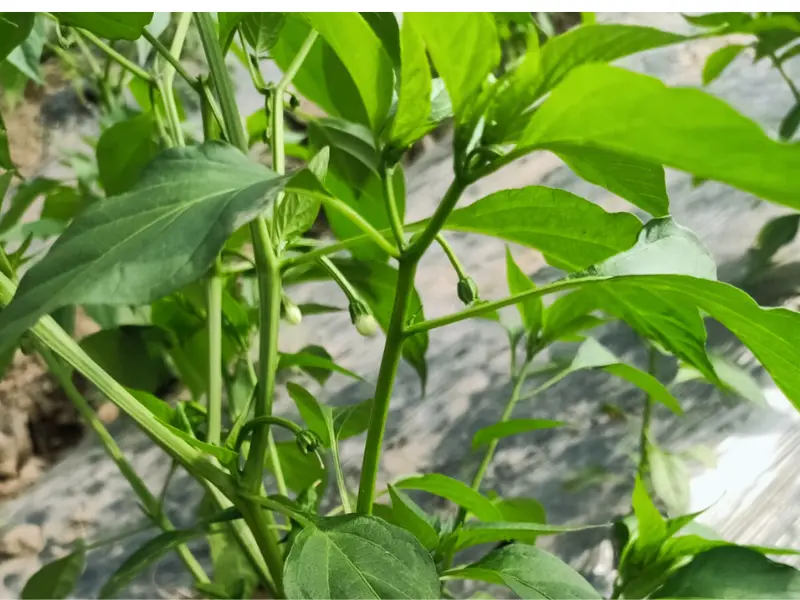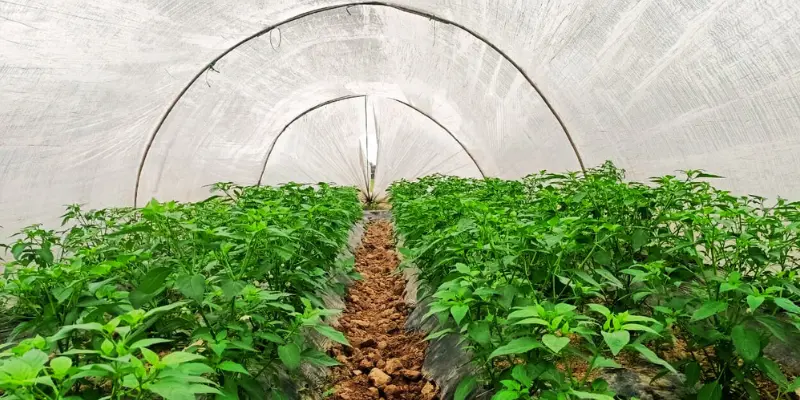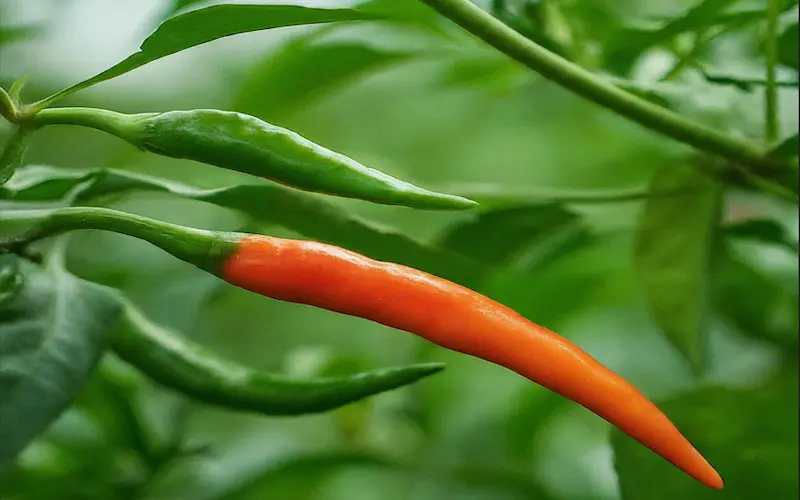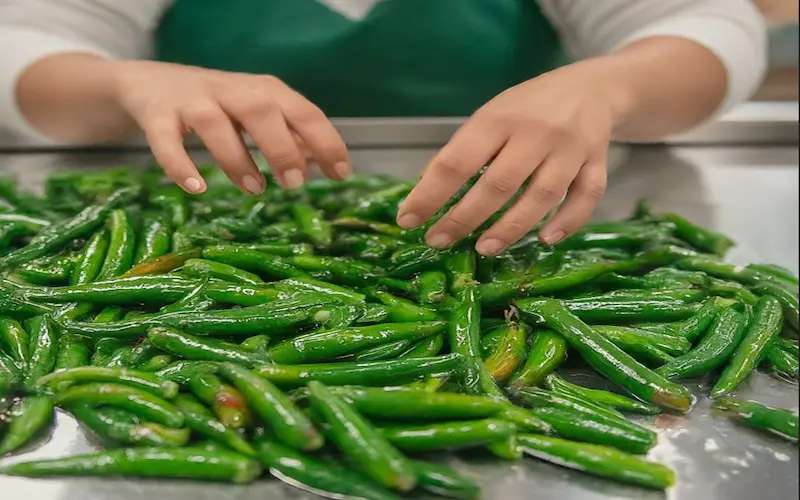Spice Up Your Garden: Essential Chilli Cultivation Tips
Updated: 5 Dec 2023
200
Chilli cultivation is a robust agricultural practice that requires meticulous planning and execution. In this blog post, I will explore the essential chilli cultivation tips for getting maximum yield in ideal climate conditions and also guide you about popular varieties and pest management.
Join us on this journey through the red-hot fields of chilli cultivation, as we explore the key steps and nuances that contribute to a thriving harvest. Whether you’re a seasoned farmer or a curious enthusiast, this concise guide promises insights that spice up your understanding of chilli cultivation. Let’s dive into the heart of this agricultural adventure and uncover the secrets behind growing the perfect chilli crop.

Ideal Conditions for Chilli Cultivation
Chilli cultivation thrives under specific environmental conditions, ensuring optimal growth and yield. Understanding these ideal conditions is crucial for farmers aiming to maximize their harvest. This section delves into the key factors that contribute to the successful cultivation of chillies.
A. Climate
- Temperature:
- Chilli plants flourish in warm temperatures ranging between 20 to 30 degrees Celsius.
- Extreme cold can stunt growth, while excessive heat may lead to flower drop, affecting fruit formation.
- Rainfall:
- Adequate and well-distributed rainfall is essential during the growing season.
- Chilli plants are susceptible to water stress, which can impact fruit development and quality.
- Seasonal Considerations:
- Cultivation of chilli is typically carried out during specific seasons, depending on the region.
- Understanding the suitable seasons for sowing and harvesting ensures a bountiful yield.

B. Soil
- Chilli plants thrive in well-drained, loamy soil with good organic content.
- A slightly acidic to neutral pH level between 6.0 and 7.0 is ideal for optimal nutrient absorption.
- Heavy clay soils can impede drainage, leading to water logging issues detrimental to chilli plants.
C. Popular Chilli Varieties and Their Yield
- Different chilli varieties exhibit varying heat levels, sizes, and colors.
- Farmers often choose varieties based on market demand, climate conditions, and intended use.
- Understanding the characteristics of popular chilli varieties helps in making informed cultivation decisions.
In essence, mastering the ideal conditions for cultivation of chilli involves a nuanced understanding of temperature, rainfall, and soil characteristics. This knowledge empowers farmers to create an environment where chilli plants thrive, ultimately leading to a successful and rewarding harvest.
Chilli Cultivation Tips and Practices
Successful chilli cultivation involves a series of meticulous practices, from land preparation to irrigation. This section provides a step-by-step guide to these essential cultivation practices, ensuring a robust foundation for a thriving chilli crop.
A. Land Preparation
- Before planting, chilli farmer ensure the soil is well-prepared through plowing and harrowing.
- Incorporate organic matter to improve soil fertility and structure.
- Level the field to facilitate uniform water distribution during irrigation.
B. Sowing and Transplanting
- Sowing Temperature:
- Optimal sowing temperature ranges between 20 to 25 degrees Celsius.
- Chilli farmer to ensure seeds are sown at the right depth for germination success.
- Transplanting Techniques:
- Start seedlings in a nursery, transplanting them to the main field after 25-30 days.
- Transplant during the evening to minimize transplant shock.
C. Nursery Management
- Maintain a well-organized nursery with proper spacing between seedlings.
- Provide adequate shade and water to prevent stress during the early growth stage.
D. Seed Selection and Treatment
- Choose high-quality seeds from reliable sources.
- Treat seeds with fungicides to prevent diseases during germination.
E. Fertilization
- Apply well-balanced fertilizers based on soil nutrient analysis.
- Incorporate organic manure to enhance soil fertility.
F. Weed Control
- Regularly weed the field to prevent competition for nutrients.
- Use mulching to suppress weed growth and conserve soil moisture.
G. Irrigation Methods
- Implement drip or furrow irrigation for efficient water use.
- Ensure consistent soil moisture, especially during flowering and fruiting stages.
Understanding and implementing these cultivation practices play a pivotal role in the overall success of chilli farming. From preparing the land to managing the nursery and adopting effective irrigation methods, each step contributes to creating an environment conducive to robust chilli plant growth.
Pest and Disease Management
Chilli plants are susceptible to various pests and diseases that can significantly impact yield and crop quality. In this section, we explore the essential measures for effective pest and disease management in cultivation of chilli.
A. Plant Protection Measures
- Chilli farmer to Implement preventive measures such as crop rotation to reduce the risk of diseases.
- Use physical barriers like row covers to protect plants from pests.
B. Common Pests and Diseases
- Pests: Identify and control common pests such as aphids, thrips, and mites.
- Beneficial insects like ladybugs and predatory mites can be employed for natural pest control.
- Diseases:
- Recognize symptoms of diseases like powdery mildew, bacterial spot, and anthracnose.
- Apply fungicides or biopesticides to manage fungal infections.
C. Integrated Pest Management (IPM)
- Adopt IPM strategies that combine biological, cultural, and chemical control methods.
- Monitor pest populations regularly to implement timely interventions.
By proactively addressing pest and disease challenges, chilli farmers can safeguard their crops and ensure a healthy, productive harvest. The integration of preventive measures, identification of common pests and diseases, and the implementation of holistic pest management strategies contribute to the overall resilience of the chilli cultivation system.
Harvesting and Post-Harvest Handling
The culmination of the chilli farming journey is the harvesting and subsequent post-harvest handling, critical stages that directly impact the quality of the final produce. In this section, we delve into the nuances of these processes for optimal results.

A. Harvesting Techniques
- Harvest chillies when they reach the desired maturity, typically when they attain full color.
- Use sharp, clean harvesting tools to minimize damage to the plants.
- Harvesting should be done carefully to avoid bruising or injuring the fruits.
B. Post-Harvest Handling
- Sort chillies based on size, color, and quality to meet market preferences.
- Pack harvested chillies in well-ventilated containers to prevent moisture build-up.
- Store chillies in a cool, dry place to maintain their freshness and quality.

C. Storage and Packaging
- Optimal storage conditions include low temperatures and controlled humidity.
- Use packaging materials that protect chillies from physical damage and external contaminants.
- Implement proper labeling for traceability and consumer information.
Successful post-harvest handling ensures that the quality of chillies is preserved from the field to the consumer, maximizing their market value. By adopting careful harvesting techniques and meticulous post-harvest practices, farmers can extend the shelf life of chillies and deliver a premium product to the market. This section equips chilli cultivators with the knowledge needed to navigate these crucial stages of the agricultural cycle successfully.

Equipment and Tools: Chilli Cultivation Tips
Cultivation of chilli involves a range of specialized equipment and tools that contribute to efficient and effective farming practices. In this section, we explore the diverse array of agricultural implements used in different stages of chilli cultivation.
A. Tillage Implements
- Ploughs: Utilize implements like disc ploughs, moldboard ploughs, and subsoil ploughs for initial soil preparation.
- Harrows and Rollers: Employ disc harrows, land rollers, and rotary hoes for refining the soil surface.
B. Planting and Sowing Equipment
- Seed Drills: Both manually operated and tractor-operated seed drills ensure precise sowing of chilli seeds.
- Planting Equipments: Equipment like potato planters and sugarcane planters facilitates efficient planting.
C. Plant Protection Tools
- Sprayers: Various types of sprayers, including boom sprayers, knapsack sprayers, and motorized backpack sprayers, are crucial for applying pesticides and fertilizers.
- Dusters: Hand rotary dusters and mist blowers aid in distributing pesticides evenly.
D. Harvesting Equipment
- Combine Harvesters: Mechanized harvesters streamline the harvesting process, increasing efficiency.
- Threshers: Essential for separating chilli seeds from the harvested crop.
E. Miscellaneous Tools
- Welders: Tools like dry land welders and long handle welders help in weed control.
- Sowing Wide Bed Former: Facilitates efficient sowing in wide beds.
- Zero Till Seed Cum Fertilizer Drill: Promotes minimum soil disturbance during sowing.
Understanding and employing the right equipment at each stage of cultivation of chilli significantly enhances productivity and reduces manual labor. The diverse range of tillage implements, planting tools, plant protection equipment, and harvesting machinery contributes to a streamlined and efficient chilli farming operation. Cultivators equipped with the appropriate tools are better positioned to navigate the complexities of modern agriculture and optimize their chilli farming endeavors.
Related Topics
Chilli farming is part of a broader agricultural landscape that encompasses various crops, livestock, and horticultural practices. In this section, we explore related topics that complement and enrich the understanding of chilli cultivation.
A. Other Crops in Agriculture
- Explore the diverse array of crops grown in agriculture, including cereals, oilseeds, pulses, and more.
- Understand the interplay between different crops and their impact on overall agricultural practices.
B. Livestock and Poultry
- Delve into the realm of livestock farming, including cattle, poultry, goats, and other domesticated animals.
- Explore the symbiotic relationship between cultivation of chilli and livestock management.
C. Horticulture and Forestry
- Gain insights into horticultural practices involving fruits, vegetables, and ornamental plants.
- Understand the significance of forestry in promoting ecological balance and sustainable farming.
By exploring these related topics, chilli cultivators can broaden their knowledge base, adopting holistic approaches to agriculture. The interconnection between different facets of farming provides a comprehensive perspective that goes beyond individual crop management. As chilli farming is intricately linked to larger agricultural practices, understanding related topics enhances farmers’ ability to make informed decisions, fostering a sustainable and integrated approach to agriculture.
Support for Agriculture
Chilli farming, like any form of agriculture, thrives when supported by a robust system of information, technology, and community initiatives. In this section, we explore the various avenues of support available to chilli cultivators.
A. Magazines and Publications
- Agri-Journals: Accessing agricultural journals and magazines provides farmers with the latest research, trends, and best practices in chilli cultivation.
- Subscription Services: Subscribing to relevant publications ensures a steady influx of valuable information.
B. Agri-Journalism Initiatives
- Awareness Programs: Participation in agri-awareness programs fosters knowledge sharing and community building.
- Media Platforms: Utilize online and offline media platforms dedicated to agriculture for information exchange.
C. Research and Development
- Institutes and Organizations: Collaboration with agricultural research institutes and organizations enhances access to cutting-edge technologies and practices.
- Field Trials: Participating in field trials and research projects allows farmers to contribute to and benefit from advancements in cultivation of chilli.
D. Financial Support
- Government Schemes: Avail benefits from government schemes and subsidies that support chilli farming.
- Financial Institutions: Explore financial support options from banks and agricultural credit institutions.
- By leveraging support from various sources, chilli cultivators can stay informed, adopt innovative practices, and overcome challenges effectively. The synergy between research institutions, media platforms, and financial support creates an environment conducive to sustainable chilli farming. This section emphasizes the importance of staying connected to broader agricultural networks to ensure continuous improvement and resilience in chilli farming.
Conclusion
In conclusion, the journey through the intricacies of chilli farming unveils a tapestry of essential practices, from ideal environmental conditions and meticulous chilli cultivation tips to vigilant pest management and thoughtful post-harvest handling. The interplay of equipment, related agricultural topics, and crucial support systems further enriches the landscape of chilli farming. As cultivators navigate the nuanced realms of temperature, soil, and harvesting, they find themselves armed with knowledge that not only ensures a flourishing chilli crop but also contributes to the broader canvas of sustainable agriculture.
By embracing innovation, staying informed, and fostering community engagement, chilli cultivators can not only optimize their yields but also pave the way for a resilient and thriving agricultural future. This guide serves as a compass, guiding both seasoned farmers and eager enthusiasts through the vibrant world of chilli cultivation, where every step taken resonates with the promise of a fruitful harvest and the continued evolution of agricultural practices.
Please Write Your Comments